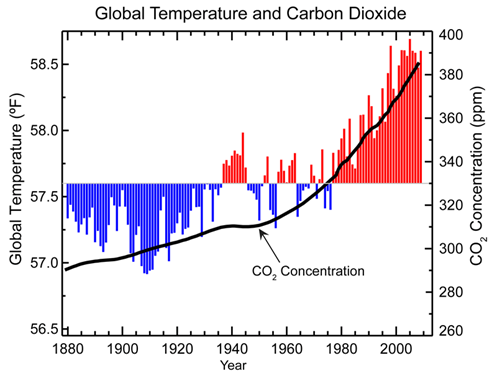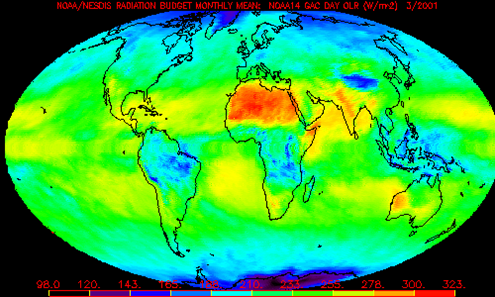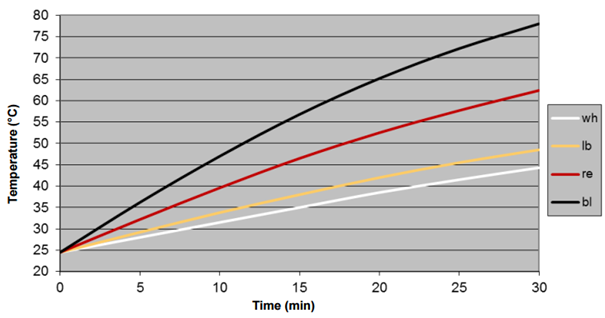eISSN: 2576-4543


Review Article Volume 2 Issue 6
Honorary Research Director, University Paris?Saclay, France
Correspondence: Boris Tatischeff, Honorary Research Director, University Paris?Saclay, Orsay rue Georges Clemenceau Orsay, F?91405, France, Tel 3316 9155 172
Received: January 23, 2018 | Published: November 15, 2018
Citation: Slama RB. Modification of the terrestrial albedo following the absorption of the solar radiation by the dark artificial surfaces and its influence on the green house effect. Phys Astron Int J. 2018;2(6):508-512. DOI: 10.15406/paij.2018.02.00133
In this article, it is implicated another factor other than that greenhouse gases in global warming. Indeed, CO2 and its equivalents retain only infrared radiation of long wavelengths. These are issued naturally by the earth at all times, but recently under the pretext of prestige or fashion, in hot countries is added the paintings of buildings in dark color, black in this case. These colors affect the albedo coefficient by the absorption of solar radiation and the emission of far infrared radiation that cannot cross the greenhouse gases, so partly reflected towards the earth causing global warming. Global action on reducing greenhouse gas emissions should therefore be complemented by a reduction in the dark color areas created by man.
Keywords: global warming, greenhouse effect, infrared radiation, emittance, dark color, hot country
Global warming seen by a solar energy expert
Specialists in the thermal conversion of solar energy are well aware that a solar air or water collector consists mainly of all of the following elements: a black absorber, glazing, insulation and trunk. For this to heat up and rise in temperature, it is first necessary to absorb the incident solar radiation, then to save the heat comes the role of the insulator on the back side of the collector and glazing on the front side. The latter must be selective i.e. be transparent to the incident solar light of short wavelength and opaque to the far infrared radiation emitted by the absorber of the solar collector.
On the side of global warming, it is well known that CO2 is a greenhouse gas. It is less known that greenhouse gases allow almost all of the radiation from the sun to pass but are almost opaque to far infrared radiation from the earth.
On the other hand, we do not differentiate the origin of the infrared radiation emitted by the surface of the earth.
We distinguish
The alarm bell is thus drawn because in addition to what has existed for a long time (roads), we are currently witnessing a dangerous turn because many buildings (even old) are painted in black, blue, brown etc. or having large windows, which makes them hot following the absorption of solar radiation, they then emit a type of far infrared radiation, naturally stopped by greenhouse gases in the same way as the infrared radiation emitted by the planet earth day and night. Thus global warming is increased. It remains to quantify this increase. What is certain, however small, is that, this effect is harmful, and hence there is reason to act to limit the extent of the artificial surfaces that emit it.
If the fraction of the mass of CO2 rejected annually in the sky compared to that of the atmospheric gas that surrounds the earth is about 7.10-6 (i.e. 35.1012 / 5.1480.1018), however, all the international conventions point to CO2 as the cause of global warming because it plays the role of a greenhouse gas (conference of parties COP 21 and 22). By analogy, it seems to us necessary to consider the part of the infrared radiation emitted by the artificial surfaces vis-à-vis the radiation emitted naturally by the earth; because moreover, it is emitted by surfaces at much higher temperatures, where the energy emittance is double. Moreover, in the future the extent of these surfaces increases with the extent of cities.
Global warming due to the greenhouse effect is therefore not only CO2 emissions but also infrared radiation not only emitted naturally by the earth, but also artificially by human constructions of dark color. Such an increase deserves, in our opinion, to be considered before it is too late because urban planning is only increasing as a result of population growth and in the absence of laws that limit the phenomenon; especially in countries with strong sunshine.
Global warming is a reality that no one can deny, as shown in Figures 1 & Figure 2.

Figure 2 Annual Mean Temperature compared to the 1961-1990 average.1
In 1909, Robert Williams Wood shows that contrary to popular belief, the blockage of infrared radiation by glass is not the main mechanism that explains the operation of a greenhouse. Therefore the scientific term, adopted by the IPCC, used to describe the influence of the components of the atmosphere blocking infrared radiation on the Earth's heat balance is radiative forcing and not greenhouse effect.
He demonstrated in 1909 the erroneous nature of the explanation of the greenhouse effect by the trapping of infrared rays by glass; simply by replacing ordinary glass with halite transparent to these rays (the explanation lies almost exclusively in the blocking convection).
Let's say it's true in a greenhouse, the warming is both the imprisonment of infrared rays and the reduction of convective losses because the greenhouse is hermetically closed; this is how, for the case of solar water collectors, there are those that are under vacuum to completely eliminate convective losses. Note that for agricultural greenhouses, farmers open the doors to create a draft in case of overheating in the presence of solar radiation. These are not the only ones responsible for warming a greenhouse, but it is the cover that mitigates the convective losses of the greenhouse with the outside ambient air. There are indeed double-glazed greenhouses in glass or plastic.1
Figure 3 shows that if there is no greenhouse effect (natural) the earth would be freezing. However, human activities have generated a lot of greenhouse gas emissions, which has significantly magnified the greenhouse effect and caused global warming. Ben Slama R2−7 explains that while it is undeniable that the increase in CO2 emissions and its equivalents is causing the greenhouse effect, it should be noted that CO2 only stops far-infrared radiation, not the visible radiation for example. However, many human-built (roads, buildings, etc.) and dark-colored construction surfaces absorb solar radiation and re-emit it into the far-infrared spectrum to which greenhouse gases are opaque; the radiation is returned to the earth causing global warming.
On the bibliographic illustration side, some authors mention the link between infrared radiation emitted by the surfaces of internal and external buildings.8 Other authors evoke the close link between radiation received and emitted by the earth and global warming.9−12
Kasztendeuch et al.13 as well as Koncou et al.14 evoke the city atmosphere interaction in the perception of solar radiation, the projection of the shadow and the night warming especially in summer. A study by Ben Slama15 shows the perception of solar radiation according to their impact on the walls of buildings for example.
In fact, the atmosphere, the oceans and the surface of the continents absorb solar radiation (short wavelengths: 0.25 to 2.5 micrometers: solar spectrum). Thus, the Earth (surface and atmosphere) emits infrared radiation (between 5 and 100 micrometers). This radiation is emitted to space and therefore represents a loss of energy for the Earth. The overall balance is therefore zero. However, in the presence of GHGs, this far-infrared radiation is not transmitted to space13,14 but sent back to the earth causing its warming, hence the climate change of which humanity is well aware (Cf. COP 21 in Paris, November 2015, COP 22 in Marrakech, November 2016, COP 23 in Bonn, November 2017).
The infrared radiation of the Earth can be measured by satellites equipped with sensitive sensors to this radiation and redirected towards the Earth. The image in Figure 4 represents an average of the measurements taken during the month of March 2001.

Figure 4 IR radiation emitted by the earth.10
The IPCC reports evoke the impact of albedo modification on global warming, indicating that the melting of the ice of the poles would lead to a decrease in albedo and consequently a greater absorption of solar radiation and therefore warming. However it does not evoke the variation of the albedo of the constructions (roads and buildings) in the sunny countries!!!! and which is growing more and more. By prestige search people choose dark colors for buildings. For cold countries, with low tau of sunshine, the dark color of the artificial structures of cities has little effect on infrared emissions; which is not the case for very sunny countries.
Being specialist in solar energy, thermal conversion, and to understand the purpose of this article, it is more explicit to start with a reminder of the thermal capture of solar radiation, with which I find that there is a similarity with the theme treated here since both are concerned by the greenhouse effect, but one favorably and the other adversely.
The principle of solar collectors is well known. They consist of an absorber (black), glazing (to create the greenhouse effect and causing the absorber to warm up), and thermal insulation to conserve heat (Figure 5). To heat, it is necessary to place a window which lets the solar spectrum pass and which reflects thereafter the infrared radiation emitted by the absorber; moreover, black; this is how Far Infrared IR is produced.
Against example: Imagine now that the absorber is white, it will therefore directly reflect the incident solar radiation, which will be possible to cross the window "selective"; so there will be no heating up in the solar collector!
By analogy, these observations of the phenomenon of the greenhouse effect at the scale of the solar collector, can be extrapolated on the planet earth scale concerning its reception of the solar radiation and its heating by the GHGs. Figure 6 shows this phenomenon: transmission of solar radiation and reflection of infrared radiation.

Figure 6 Earth, sun, Infrared emissions and global warming by GHGs.15
Evolution of the area of artificialized areas: in the year 2000, the global urban coverage represented 0.5% of the total land area. In 2030, the urban space will have tripled in area, i.e. 1.2 million km2 of additional surface area (in all 1.8 million km², i.e. 1.5% of the total land area). In 2050, cities are home to 65% of the world's 9.5 billion people. In France, artificialized areas (tarred, built) occupy 4.9 million hectares in 2010, i.e. nearly 9% of the metropolis.
Climate impact
During the day, in the presence of clear sky sunshine, at the terrestrial radiation emissions in the IR spectrum towards the atmosphere, is added the infrared radiation emitted by artificial structures of dark color such as roads, cities, cars and even the clothes of individuals who emit in the same order of magnitude of wavelength; this is the latent object of this reflection and the writing of this paper.16
Obviously this only concerns the surplus daytime radiation due to artificial elements that absorb solar radiation. (Figures 7-9) Thus, CO2 plays the role of greenhouse gas GHG only if it is opposed to infrared radiation emitted by the surface of the earth, during the crossing and the penetration of the atmosphere, a natural way. This IR radiation is of the distant type. Added to this are the IR emissions of the dark and therefore warm surfaces of artificial structures built by man on the earth. It is therefore urgent to limit the area of these emitting surfaces and to avoid their expansion.
The power radiated by a matt surface, heated by the sun and according to its temperature is given by:
And the corresponding average wavelength is given by:
It should be noted that the power emitted at 70°C is almost twice that at low temperature (20°C)(Table 1). Surfaces should not be heated by the effect of the sun. However, the sun cannot be easily avoided. On the other hand, it is possible to avoid its absorption by the use of clear and non-dark surfaces. Indeed, the absorption coefficient of solar radiation by a surface depends on its color, as shown in Figure 10 & Figure 11.17
|
Surface Temperature |
20 °C |
30°C |
40°C |
50°C |
60°C |
70 °C |
|
Average wavelength of radiation (mm) |
9.89 |
9.56 |
9.25 |
8.97 |
8.7 |
8.44 |
|
Power of radiation causing the greenhouse effect (W/m²) |
417 |
478 |
544 |
617 |
697 |
785 |
Table 1 Particulars

Figure 10 Influence of surface color on the absorption, reflexion and albedo coefficients of solar radiation.17
A) Solar absorption coefficient B) Solar reflection coefficient C) Albedo coefficient.

Figure 11 Influence of the surface color on the reached temperature.17
In addition, the heating of the surfaces following the absorption of solar radiation has several harmful consequences:
The infrastructure of the cities (roads and buildings) but also the roads and the vehicles participate, especially in the countries with strong sunshine to modify the temperature of the globe in the sense that, the day, being exposed to the solar radiation, their surfaces if they are dark absorb all the solar radiation and re-emit in the far infrared spectrum, all the more energetic as the temperature is high, so that the surface is dark (black in particular). However, far infrared radiation does not cross the atmosphere and therefore favors radiative forcing and consequently the greenhouse effect. In our warm countries, and more than in the cold Nordic countries, it is urgent to stop the expansion of the use of dark colors for any surface exposed to the sun; walls, roads, roadways, vehicles and even our clothes.18−21
While limiting greenhouse gas emissions is of primary interest to industrialized countries, hot countries are also implicated in the greenhouse effect in reducing dark surfaces exposed to the sun.
None.
Author declares there is no conflict of interest.

©2018 Slama. This is an open access article distributed under the terms of the, which permits unrestricted use, distribution, and build upon your work non-commercially.